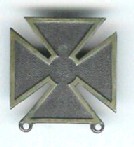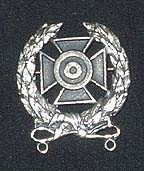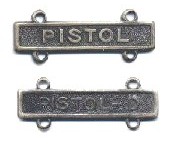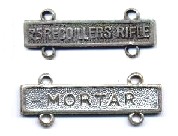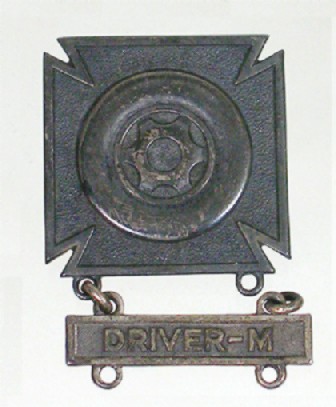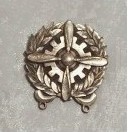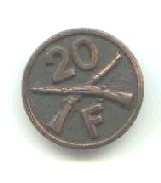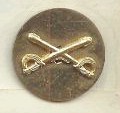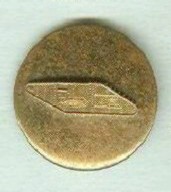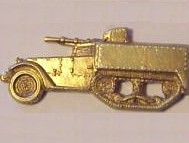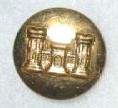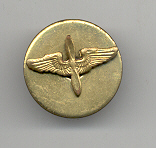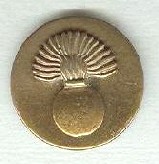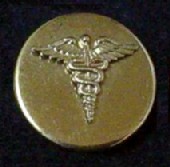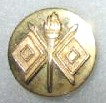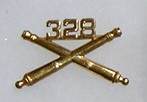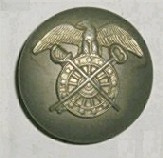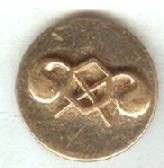.
Dated: April 31, 006
U.S. Uniforms
and
Insignia and Medals
Worn by Veterans of the Italian Campaign
This page provides information to help
research
the uniforms, medals and ribbons in your collection. The
soldiers
in Italy wore a wide variety of uniforms. There is no way to
describe
all of them in detail. Similarily, there are many medals and
awards
that could be earned by soldiers in Italy, which I will not
cover.
This page only covers the basic uniforms of the Infantryman and the
Campaign
Medal (and ribbon) and other insiginia that was common for soldiers in
Italy. Of course, the details on how the medals and patches were
worn on the uniform would apply for soldiers in France or Germany, as
well.
During war, the Campaign Medals and Good Conduct
Medal
were awarded with only a ribbon, as the medal was usually not
available.
Therefore, when you send in the form to the Government requesting
personel
records, they will send a set of medals with the veteran's name
inscribed
on the back. They will only do this if the veteran signs
the
form.
The patches and pins worn on the US uniform were
optional
for some units. These were not worn in combat, of course; only on
the dress uniform or the Ike jacket. On the lapels of the collar
were usually worn a disc with "US" and the branch insignia and, below
this,
maybe a pair of unit insignia. There were hundreds of unit
insignia
pins. This page illustrates a few of the examples worn by units
in
Italy.
Menu for this Page.
| Medals
& Ribbons |
Medals earned for service in the Italian Campaign. |
| Patches
& Badges |
Sleeve patches, proficiency
badges and other insignia |
| DUI
Pins |
Distinguishing Unit Insigina Pins worn by units
serving in Italy. |
| Branch
Pins |
Collar
discs,
indiating branch of service. |
US
Divisions Table - Contains images of the Division shoulder patches
for ALL infantry divisions of the Army.
Also includes a table of the infantry regiments & artillery
battalions
for each division.
This section provides
information
on the medals and ribbons that would be worn on the uniform of a
soldier
who served in the Italian Campaign.
Campaign Medals
earned
by most soldiers who served in the Italian Campaign.
It is common for a
soldier
to have 3 of these medals. Did not usually have all four.

|

|

|

|
|
American Campaign Medal - WWII
Service outside
the U.S.
in the American theater for 30 days.
|
European - African - Middle Eastern Campaign
Medal
Service in
the European
- African- Middle Eastern theater for 30 days.
|
American Defense Service Medal
Service
for 12 months
of active duty in Army, 1939-41.
|
World War II
Victory Medal
Service in
US Armed
Forces between 1941 and 1946.
|
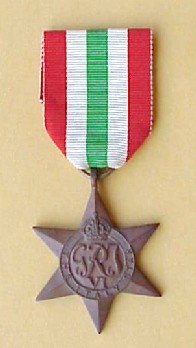
|
British
"Italy Star" Campaign Medal
Since
my site includes info on the British soldier, I thought it should
include
the campaign medal awarded to British soldiers for their service in
Italy.
The British
were more specific on their campaign medals. Whereas, the US
issued
one medal for all of Europe, Africa and Middle East, the Brits issued
several
different campaign stars
with the same basic shape. Each star had
a unique ribbon, with the Italy Star in the national colors of
Italy.
Description
Front:
King's mongram & crown, with "THE ITALY STAR" embossed in ring.
Obverse:
Name of soldier was stamped on the back. Most other medals had
the
name stamped on the edge.
|
Tip
for Bad Spellers:
Army medals
are made out of metal. |
This section provides
information
on the patches, badges and other insignia that would be worn on the
uniform
of a soldier who served in the Italian Campaign.
Sleeve
patches
other than rank and Divisional patches.
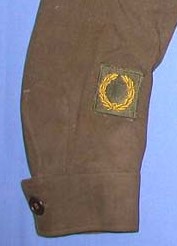
Right Sleeve
|
Lower
Sleeve Patches
Service Stripes (Left Sleeve) >
In addition
to the basic medals above, Service Stripes were worn on the lower right
sleeve. One straight stripe was awarded for each 6 months of
service
overseas. It was not necessary to serve in combat to receive
these
stripes.
<
Distinguished
Unit (Right Sleeve)
Wreath patch
denotes a member of a distinguished unit.
<
As viewed by
wearer >
|
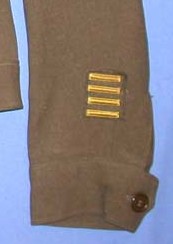
Left Sleeve
|
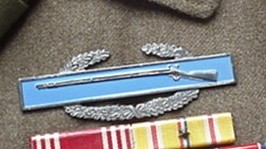
|
Combat
Infantryman's Badge
The CIB was
awarded to any Enlisted soldier who was classified as an Infantryman
and who saw combat. Therefore, it was not
awarded to medics, artillerymen nor airmen.
It was
awarded
in different classes and was worn on the Left Breast, above the ribbons.
In
1947, the Government
approved the Bronze Star Medal for every infantryman who earned the CIB. |
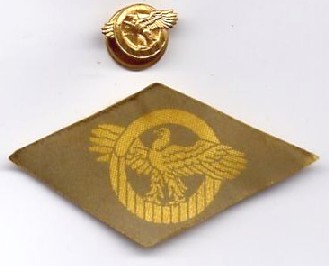
|
Discharge Pin &
Patch
aka
"Ruptured Duck"
The Discharge
Pin or Patch was issued to discharged soldiers and was worn above the right
breast pocket. The main purpose of this patch was it allowed the
GI to travel home while wearing his uniform and not be ordered around
by
an officer.
It got its
nickname from the ugly Eagle in the center.
|
Proficiency
Badges were badges earned during training for things such as
marksmenship
and driving and aircraft mechanic. These badges were worn below
the
ribbons on the left breast pocket. The most common badge worn by
infantrymen were the Marksman, Sharpshooter, and Expert Shooting
badges.
The Marksman badge was a plain maltese cross. The Expert Shooting
badge had a bullseye in the center. The Expert Shooting badge had
a wreath around the cross.
These
badges were earned by qualifying with a specific weapon.
Therefore,
these badges would have a bar hung under the badge the identified the
weapon.
Each bar was embossed with "RIFLE", "GRENADE", "BAYONET", etc.
There
were many different types of weapons. Cavlary troops would
qualify
with a weapon while mounted or dismounted. Thus, their bars were
marked as "CARBINE-M" or "PISTOL-D". It was not unusual to see a
soldier wearing 4, 5 or 6 bars hanging from his Sharpshooter
Badge.
See Staff
Sergeant Walker's photo, below. |
Bars or "Hangar
Bars"
for Infantry Proficiency Badges.
The Bars issued in
1930s
had a white finish.
Note: The Navy
and Marines
badges were different from the Army.
For more
information
on shoulder patches for each of the US Infantry divisions, refer to US
Divisions.
Distinguishing
Unit Insignias were worn on the uniform to identify the basic unit,
such
as an infantry regiment or medical battalion. These were made of
either brass or sterling silver and usually in the shape of a
shield.
Some were coated with enamel or painted. After the units
went
to Europe, new pins were needed for the replacement troops when they
arrived.
This resulted in the many pins were made locally in Germany and Italy.
Each DUI
Pin traced the traditions of that unit with symbols, colors or
mottos.
Some units could trace their lineage back to the Civil War. Some
symbols represent service in foriegn campaigns, such as fish for the
Philippine
Insurection or a fleur-de-lis for service in France during WW1.
DUI
Pins for the division was simply the division's shoulder patch
represented
on a pin.
The DUI
Pin was optional as many units did not seem to have one. It was
not
worn in combat but only on the 4-pocket tunic or the "Ike"
jacket.
A pair was worn on the lapels of the uniform and one could be worn on
the
overseas cap in place of the entlisted man's disk.
The pin
used one of three methods of attachment. The oldest method is the
(a) screw-on pin which had one threaded stud and a large nut.
Some
very old ones had (b) a safety pin clasp, simliar to a safety
pin.
Most of the modern pins used (c) the "clutch-back pins" which used two
pointed studs that had the modern spring-loaded caps. |
 |
PFC
Warren G.
Stichtenoth, Company C, 310th Engineer Battalion,
85th 'Custer' Division
This photos
shows the
DUI Pin of the 310th Engineer Battalion worn on the overseas cap in
lieu
of the enlisted man's branch insignia.
PFC
Stichtenoth is wearing
a combat jacket with a shirt, no tie, and a T-shirt. He displays
the Division patch and ribbons. In his right pocket is a
pen.
This would be common attire for an engineer.
A color
image of DUI of 310th Engineer
Battalion is shown in the examples below.
|
Examples
Many of these examples are from my collection. Some are WW2
vintage and some are modern
post-war versions.
These are Army-issue pins and not a souvenir of a veteran
organization.
All examples are from units that served in Italy.
PINS ARE NOT TO SCALE

Examples shown are (Left
to Right) :
- 85th Infantry Division
(Note
background is tan and not green, as on the shoulder patch),
- 158 Field Artillery (FA) Battalion of 45th Infantry Division,
- 599 FA Btln of 92nd Infantry Division, "FIDEM
SERVO", [Italian
made]
- 151 FA Btln of 34th Infantry Division, "EN
AVANT",
-
350 Infantry Regiment of 88th Infantry
Division,
"Fidelity
and Service" [Italian made]
- 179 Infantry Regiment of 45th Infantry Division, "INOMNIA
PARATUS", (All
Oklahoma
units had an Indian head above crest)

More examples from
Italian
Campaign (Left to Right)
:
- 142nd Infantry Regiment of 36th Division, "I'LL
FACE YOU"
- 370th Infantry Regiment of 92nd
Division,
"POWER
TO STRKE"
- 349th Infantry Regiment of 88th
Infantry
Division, "LIBERTY
AND RIGHTS"
- 351st Infantry Regiment of 88th
Infantry
Division
- 310th Engineer Battalion of 85th
Infantry
Division, (Polar Bear denotes their service in
Russia
in 1918-19)
- 442nd Regimental Combat Team, "GO
FOR
BROKE" (independant unit assigned to
34th &
92nd Divisions).

(Left to Right)
- 135 Infantry Regiment of 34th Infantry Division "TO
THE LAST MAN"
- 157 Infantry Regiment of 45th Infantry Division ""
(Two teepees and a sea-lion figure.)
- 180 Infantry Regiment of 45th Infantry Division "TANAP
NANAIYAKIA ALTHAIYANA " (Cherokee language?)
- 371 Infantry Regiment of 92nd
Infantry
Division
"ATTACK"
-
362nd Infantry Regiment of 91st Division,
"ARMA
TUENTUR PACEUM"
-
85th Mountain Regiment of 10th Mtn Division "FIX
BAYONETS" (mini-DUI;
smaller
than others)

(Left to Right)
-
328 Field Artillery Btn of 85th Infantry
Division
"WE
ARE READY" (This version of pin does not
have
a scroll.)
-
329 Field Artillery Btn of 85th Infantry
Division
"SINE
MORA"
-
337 Field Artillery Btn of 88th Infantry
Division
-
143 Infantry Regiment of 36th Infantry Division "ARMS
SECURE PEACE"
- 109 Engineer Battalion of 34th Infantry Division
-
168 Infantry Regiment of 34th Infantry Division "ON
GUARD"

(Left to Right)
- 120 Medical Battalion of 45th Infantry Division "WE
DO"
- 47 Armored Medical Battalion of 1st
Armored
Division (See
biography of Henry
Guarnere)
- 313 Medical Battalion of 88th
Infantry
Division "FERO SED SAND"
- 751 Tank Destroyer Btn, support unit for 5th
Army, "ALWAYS
TO EXCEL"
- 752 Tank Destroyer Btn, support unit for 5th
Army, "FORJIS"
- 759 Tank Destroyer Btn, support unit for 5th
Army.
|
Tradition -
The design of the DUI Pin were intended to tell the story of the
regiment's
history and tradition that dated back to World War 1 or even as far
back
as Civil War or Revolutionary War. The colors usually indicated a
branch of the Army; for example, blue
stands for infantry and red for artillery.
Some symbols on the shield represented the tradition of their origin
and
their local state. The bold lines, chevrons or wavey lines
sometimes
referred to the front lines of WW1. A Loraine cross or a
fleur-de-lis
also indicated service in France in WW1. Acquatic creatures
represented
service in the Phillipines in Spanish-American War. A prickly
pear
cactus represents service on the Mexican Border. |
The
Branch of Service insignia was worn on every uniform even if the other
insignia or patches were not. This insignia was worn on
the
lower left collar lapel with the "US" insignia on the lower right. The
officer's insignia differed in that theirs were not
mounted
on a round disk. Officers also wore theirs branch insignia on
their shirt
collars. All insignia are for enlisted men except where noted.
Insignia
are NOT to scale.
|
Return to Top
of Page
.









